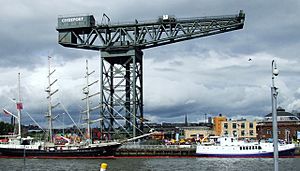Finnieston Crane facts for kids

The Finnieston Crane is a huge, old crane in the heart of Glasgow, Scotland. It's not used anymore, but it stands tall as a symbol of Glasgow's amazing engineering past. This giant crane was once busy loading heavy cargo, like steam locomotives, onto ships. These ships would then sail to countries all over the world.
The Finnieston Crane is one of only four similar cranes left on the River Clyde. There used to be five, but one was taken down in 2007. It's also one of only eleven giant cantilever cranes still existing anywhere in the world! You can often spot the crane in the background of news shows from BBC Pacific Quay.
Contents
A Look Back: The Crane's History
The very first crane known as the 'Finnieston Crane' was moved to Finnieston Quay in 1848. It was ready for use by the end of April that year. Reports from the time said this crane would be used only for lifting heavy machinery onto steamships.
The Queens Dock opened in August 1877. It was a large dock covering 61 acres. This dock helped Glasgow export many goods. A powerful 130-ton steam crane was built nearby in the 1890s. This old crane was later removed to make space for a bridge that was never built. The Finnieston Crane we see today was built to replace it. It was the very last giant cantilever crane built on the Clyde.
Building the Giant Crane
The current Finnieston Crane was ordered in June 1928 by the Clyde Navigation Trust. This group managed Glasgow's port and dock facilities. The crane was finished in 1931 and started working in 1932.
The tall tower was built by Cowans, Sheldon & Company. The long arm, called the cantilever, was built by the Cleveland Bridge & Engineering Company. The whole project cost £69,000. This was a lot of money back then! Most of the cost was paid by the Trust.
The crane is officially called the "Stobcross Crane" or "Clyde Navigation Trustees crane #7." But because it's so close to Finnieston Quay and replaced the earlier Finnieston Crane, everyone knows it as the Finnieston Crane.
Art and the Crane
The Finnieston Crane has also been part of some interesting art projects.
In the summer of 1987, a life-sized model of a train was made from straw. A local artist named George Wyllie created it. This straw train was lifted by the crane. Later, it was taken back to Springburn and burned. This revealed a metal frame underneath.
After George Wyllie passed away in 2012, a huge question mark was hung from the crane. This was a way to remember his creative work. In 2013, an American artist named Bill Fontana attached microphones to the crane. He wanted to record the sounds the huge structure made.
What Was the Crane Used For?
The Finnieston Crane was connected to a special railway line. Its main job was to lift very heavy items onto ships for export. This included things like tanks and steam locomotives.
Thousands of locomotives were brought through the streets of Glasgow. They were pulled by Clydesdale horses, special engines, and tractors. They came from factories in Springburn to the crane. From there, they were shipped all over the British Empire.
Today, the crane doesn't work anymore. But it's still kept as an important symbol of Glasgow's history and its amazing engineering skills.
How the Crane Is Designed
The Finnieston Crane is a giant cantilever crane. It stands 175 feet (about 53 meters) tall. Its long arm, or jib, stretches 152 feet (about 46 meters). It could lift a massive 175 tons! The crane could also turn a full circle in just three and a half minutes.
You can go up the crane using a steel staircase or an electric lift. This electric lift for people is the only one of its kind in Britain! The crane also has a special horizontal rail. This allowed a smaller, auxiliary crane (called a jigger hoist) to move along it. This smaller hoist was used for lighter loads.
The docks that the crane served closed in 1969. Since then, the area has been filled in and rebuilt. The North Rotunda, which was part of an old tunnel, is to the east of the crane. The Scottish Exhibition and Conference Centre and the Clyde Auditorium are to the west.
The Finnieston Crane is one of only four such cranes left on the Clyde. The Fairfield Titan crane was taken down in 2007. It is also one of only eleven giant cantilever cranes remaining in the world. You can often see the crane in the background of TV shows like Reporting Scotland and Live at Five.




